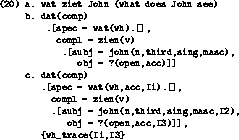


Next: WH-Movement Up: AN APPROACH TO SENTENCE-LEVEL Previous: The basic model
The definition of anaphoric relations
Anaphoric relations are defined by a type of rule that is quite different from the ordinary rules. This distinguishes the system from, for example DCG. With PATR and DCG the possibility of percolation from, say topic to trace, influences all the other rules. MiMo's approach, a separate type of rule for the anaphoric component, has the advantage of leaving the other rules, i.e the lexical I-structures, as they are. Modularity is one of MiMo's qualities. This quality is also considered important in GPSG (Gazdar et al. 1985) where it is realized by the use of metarules that multiply the number of rules. This would be undesirable in MiMo since every lexical word is its own rule. So then even the number of words would have to be multiplied.
The use of a different rule type is also motivated by the process of translating anaphoric relations. If we only used feature percolation to encode anaphoric relations, the relations established would not be explicit anymore. Annotations in MiMo are clearly distinguishable from the rest of the representation and as such make it possible to define a compositional translation of them in transfer.
Besides being modular, the system also proves to be declarative. Both qualities, modularity and declarativity, enhance the workability for the user. Changes and extensions are quite easily achieved and rules can be defined in a general way. An anaphoric component written for one particular language can often be used for another language with minor changes.
Anaphoric rules create anaphoric relations within I-structures. This
has two consequences in our system. In the first place, some of the
features of antecedent and anaphor are unified. These features are
called 'transparent'. This, for example, makes it possible to define
agreement phenomena. The linguist defines which features are
transparent with respect to a certain rule.
The motivation for this approach is discussed at length in
Krauwer et al. (1987). The main point is that identity of some but
not all features is required in an antecedent-anaphor relation.
In the second place,
the I-structure is augmented with an annotation
that specifies the binding. This
annotation consists of the name of the relation and the unique names
of the nodes between which the relation exists. The definition
of anaphoric relations makes use of these annotations (see also section 5).
A relation cannot be created unless the correct structural relation
between antecedent and anaphor exists. So the grammar writer defines
for each relation:
1) the name of the relation
2) the transparent features
3) the structural relation
An example of an anaphoric rule is the one that establishes a
relation between a wh-element and an open slot. The rule
looks like (15) MiMo
MiMo .
.
(15) wh_trace : c_command( {wh}, {open} )-
{agreement,case}
The wh-trace relation is established when the structural relation
c_command holds between a wh-constituent and an open slot. The agreement
features and the case feature are unified if possible, if not,
the relation will not be established.
The structural relation itself, c_command in this case, is defined by
the user as well. Either a simple structural relation is defined or a
complex structural relation. The latter is composed of a regular
expression over structural relations .
An example of a simple structural relation is the sister-relation, defined in (16).
.
An example of a simple structural relation is the sister-relation, defined in (16).
(16) sister(ANT,ANA) : (17) c_command:
?() .[ ? = ?(ANT), sister +
? = ?(ANA) ] ancestor
The structural relation sister holds between the I-structures ANT and
ANA if there exists an I-structure in which both ANT and ANA fill
slots. The exact nature of the LIs is not important nor are the
features or the names of the slots, hence their representation as
question marks in (16) .
A complex structural relation is defined by means of a regular
expression over structural relations. The regular expressions make
use of the operators '^', indicating optionality, ';' for
disjunction, '*' for
iterativity (0, 1 or more times ) and '+'. The latter has a special
meaning which can best be explained by means of the definition of
the c_command relation mentioned in (17).
The '+' operator indicates that
the sister relation should hold between the antecedent and some
intermediate node and the ancestor-relation between this intermediate
node and the anaphor. The Prolog-variant of (17) is (18). So, the
c_command relation holds between the I-structures ANT and ANA when
one of ANT's sisters is ANA's ancestor.
.
A complex structural relation is defined by means of a regular
expression over structural relations. The regular expressions make
use of the operators '^', indicating optionality, ';' for
disjunction, '*' for
iterativity (0, 1 or more times ) and '+'. The latter has a special
meaning which can best be explained by means of the definition of
the c_command relation mentioned in (17).
The '+' operator indicates that
the sister relation should hold between the antecedent and some
intermediate node and the ancestor-relation between this intermediate
node and the anaphor. The Prolog-variant of (17) is (18). So, the
c_command relation holds between the I-structures ANT and ANA when
one of ANT's sisters is ANA's ancestor.

The MiMo definition of 'ancestor' is given in (19a). The relation is
defined in terms of the simple relation 'mother'. The structural relation
of the latter is in (19b) .
.

Features can be added to the structural pattern to restrict the range of possible relations further. This will be illustrated in the fourth section when we discuss a possible way of treating wh-movement. To conclude this section, we give an example of an I-structure to which (15) applies. (20b) shows the structure before and (20c) after application of (15).




Next: WH-Movement Up: AN APPROACH TO SENTENCE-LEVEL Previous: The basic model
Gertjan van Noord
Fri Nov 25 13:16:14 MET 1994